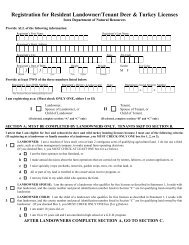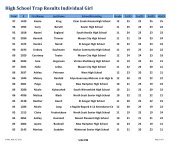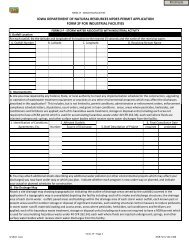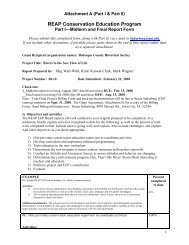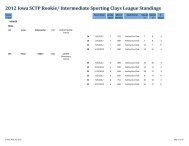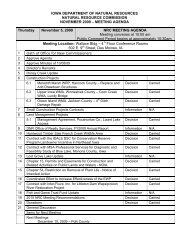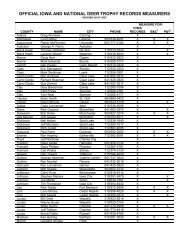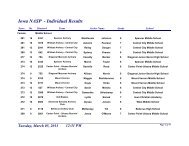Waste Reduction, Construction and Demolition Debris - Iowa ...
Waste Reduction, Construction and Demolition Debris - Iowa ...
Waste Reduction, Construction and Demolition Debris - Iowa ...
Create successful ePaper yourself
Turn your PDF publications into a flip-book with our unique Google optimized e-Paper software.
APPENDIX C<br />
Please note that the following regulatory summary was applicable at the time of publication (November 2008), for specific guidelines,<br />
regulatory changes <strong>and</strong> other information please contact the <strong>Iowa</strong> Department of Natural Resources.<br />
In addition, if your business is a Conditionally Exempt Small Quantity Generator (CESQG) (generates less than 220 pounds (100 kg)<br />
of hazardous waste or less during a calendar month) you may be able to dispose of your hazardous materials at your local Regional<br />
Collection Facility (RCC). A listing of RCCs may be found at www.iowadnr.gov/waste/hhm/index.html.<br />
What is a Hazardous <strong>Waste</strong>?<br />
Prepared by:<br />
<strong>Iowa</strong> <strong>Waste</strong> <strong>Reduction</strong> Center / University of Northern <strong>Iowa</strong><br />
(319) 273-8905 or (800) 422-3109<br />
www.iwrc.org<br />
40 CFR 261, October 2005<br />
Does my business generate a hazardous waste?<br />
A waste is hazardous if it exhibits a hazardous characteristic or if it is found on any of four specific hazardous waste lists.<br />
What are the benefits of knowing my business generates hazardous waste?<br />
Every business is responsible for characterizing its wastes. Knowing which wastes are hazardous <strong>and</strong> the amount of hazardous wastes<br />
generated <strong>and</strong> stored at your facility will indicate the level of regulation that applies to your business. The benefit of knowing this<br />
information provides the opportunity for compliance with federal environmental regulations.<br />
Characteristics of Hazardous <strong>Waste</strong><br />
According to Environmental Protection Agency (EPA) regulations, there are four characteristics that can make a waste hazardous:<br />
ignitability; corrosivity, reactivity; <strong>and</strong> toxicity.<br />
Ignitability - If liquid waste has a flash point of less than 140 o F, it is<br />
an ignitable hazardous waste. Some solid wastes are characterized<br />
as ignitable hazardous wastes if they spontaneously combust<br />
<strong>and</strong>/or meet certain ignition/burning testing criteria. Ignitable<br />
hazardous wastes have the EPA waste code of D001. Examples are:<br />
• Petroleum parts washer solvents;<br />
• Solvent-based paint waste;<br />
• <strong>Waste</strong> kerosene or gasoline; <strong>and</strong><br />
• Spent paint booth exhaust filters.<br />
Corrosivity - Aqueous wastes that have a pH less than or equal<br />
to 2.0, or greater than or equal to 12.5, are considered corrosive<br />
hazardous wastes. Corrosive hazardous wastes have the EPA waste<br />
code D002. Examples are:<br />
• Acid or alkaline cleaning solutions;<br />
• Rust removers;<br />
• Battery acid; <strong>and</strong><br />
• Caustic hot tanks waste.<br />
Reactivity - A waste is reactive if it reacts violently with water,<br />
forms potentially explosive mixtures with water, generates toxic<br />
gases when mixed with water, contains cyanides, or sulfides that<br />
are released when exposed to acid or alkaline materials, or is<br />
explosive. Reactive hazardous wastes have the waste code D003.<br />
Examples are:<br />
• Cyanide plating wastes;<br />
• <strong>Waste</strong> concentrated bleaches;<br />
• Pressurized aerosol cans; <strong>and</strong><br />
• Metallic sodium <strong>and</strong> potassium.<br />
Toxicity - A waste is toxic if it fails the Toxicity Characteristic<br />
Leaching Procedure (TCLP) lab test for any one of 40<br />
parameters. Examples are:<br />
• Painting wastes that contain toxic metal based pigments <strong>and</strong>/or<br />
certain solvents (i.e., MEK);<br />
• Treated wood waste where the treatment was done with “penta”,<br />
or pentachlorophenol;<br />
• Oily wastes, such as used oil filters that exceed the levels for<br />
benzene <strong>and</strong>/or lead.<br />
18



